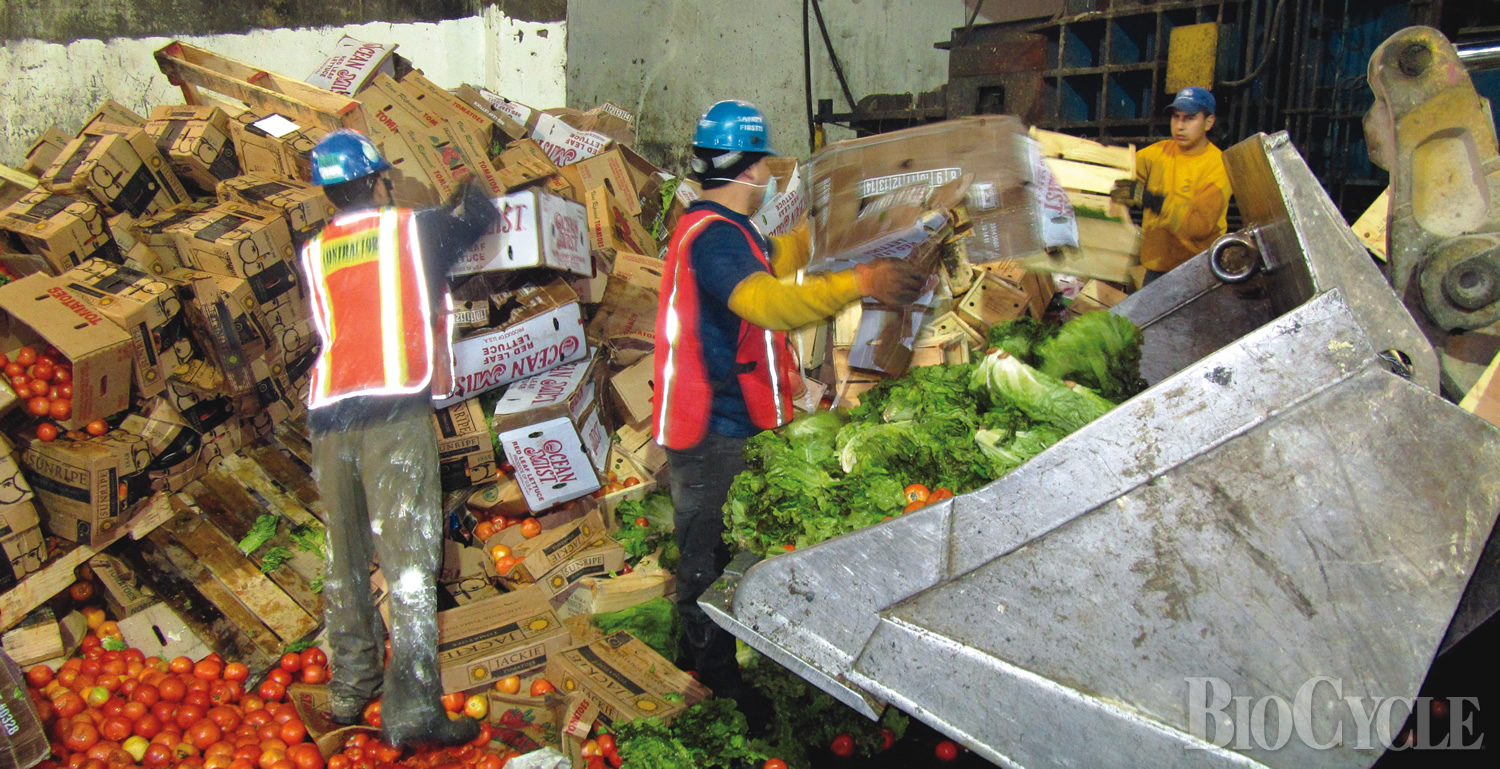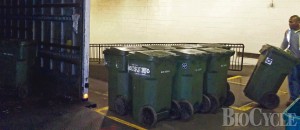The Durst Organization’s 54-story, LEED Platinum Bank of America Tower sorts organics as well as traditional recyclables.
Diane Greer
BioCycle June 2012, Vol. 53, No. 6, p. 17
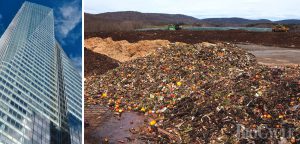
Food scraps from the cafeterias and The Durst Organization’s offices at the Bank of America Tower (left) are part of the source separated organics (right) delivered to McEnroe Organic Farm.
The Durst Organization is renowned as an innovative leader in sustainable development. Its 54-story Bank of America Tower is considered one of the greenest skyscrapers in the world, attaining LEED Platinum certification — the highest level available from the U.S. Green Building Council. Initiatives extend beyond design and construction to building management and maintenance procedures. Emphasis is placed on using renewable, reusable and recyclable materials, as well as green cleaning products. A comprehensive recycling program targets paper, cardboard, metal, plastic, glass and now food waste. Portfolio wide, the company is diverting over 80 percent of its waste from landfills.
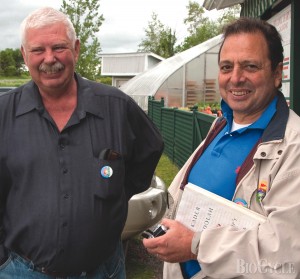
McEnroe Farm partners Ray McEnroe (left), a fourth generation farmer, and Douglas Durst, chairman of The Durst Organization (right).
Recently Durst started a pilot program to collect food waste and other organics, such as dirty napkins and wilted cut flowers, from the offices. Each pantry in the Durst offices is outfitted with bins for recycled bottles and cans, paper and trash and a 3.25-quart plastic compost pail. The lids are equipped with charcoal filters to control odors. Signage near the pails explains which items are compostable and recyclable. The pails are collected and emptied twice a day, after the morning “rush” and after lunch, into 64-gallon toters that are taken to the refrigeration room at the loading dock at the end of the day. Each weekday, Royal picks up the full toters from the loading dock and leaves a like number of empty ones that have been power washed, sanitized and deodorized.
Both the cafeteria and office pilot composting programs are working well; roughly 3,700 cubic yards/ year (cy/yr) of separated food waste are being diverted. While motivation and senior management commitment are important, the infrastructure is needed on the corporate side to make it work and make it convenient for people to separate their food waste. Providing that infrastructure adds to building maintenance costs. Offsetting these costs are potentially lower carting fees depending on waste volumes.
Hauler’s Perspective
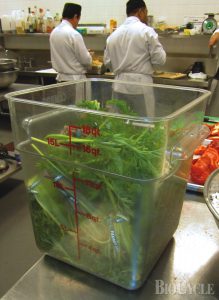
Kitchen staff is trained to place food waste and other compostable organics in specified containers.
In addition to the Durst Organization, Royal collects food waste from other office cafeterias, such as ABC Channel 7 News, ABC Carpet and Home, Vornado Realty Trust Company and Bloomberg, LLP, along with area restaurants and supermarkets. Collected organics are hauled to Royal’s transfer station in Hollis, where they are spread on a tipping floor for contaminant removal. Sorters and pickers with rakes and brooms work through the floor, literally hand picking out items such as plastics and cutlery. Bottles, plastic and cardboard are placed in recycling receptacles. The manual picking process removes 90 to 95 percent of the nonorganic material from the food waste, the level required by the composting operation, according to Guarnaccia. “It takes a lot of work at our end to make the material ready and acceptable to go to the farm.” Despite the labor costs, the lower tipping fee and transport distance to the farm make composting a more economical alternative than disposal.
Once cleaned of contaminants, the food waste is run through a screw press to remove excess liquids and then loaded onto trucks for the trip to McEnroe Farm the next morning. Royal hauls 120 to 160 cy/week of separated food waste to McEnroe Farm. This represents about 80 percent of the total food waste processed at Royal. The remaining separated organics go to other composters. Spillage and distance are the major concerns in transporting the material. “Law enforcement is quick to give a summons if they see a truck spilling or dropping materials along the roads,” Guarnaccia says.
Given fuel costs Royal does not want to transport compostable material much beyond the 95-miles to McEnroe Farm. Currently the trip to the farm at 6:00 am takes one hour and 20 minutes. The return trip can sometime take 2 hours due to traffic.
Composter’s Perspective
McEnroe Farms, one of the oldest and largest organic farms in the Hudson Valley, is a partnership between Ray McEnroe, a fourth generation farmer, and Douglas Durst, chairman of The Durst Organization and Helena’s father. The two met in 1987 when Durst, who owns horses, wanted to purchase five-acres of the McEnroe family farm to start a composting operation to sustainably manage the horse manure. As the two got to know each other they decided to partner not only in a composting operation but an organic farm. “That is when Douglas bought 220 acres, splitting the land down the middle, and they went into [the composting and farming] business together,” explains Erich McEnroe, manager of McEnroe Farms and Ray’s son.
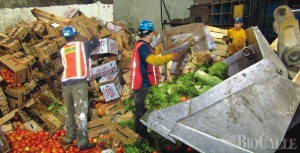
Workers separate recyclable wood boxes and food waste on the tipping floor at the Royal Waste facility in Queens.
Between 60 to 70 percent of the compost is used on the farm. “The base of our organic farming is the compost,” McEnroe explains. “That is the only true way that we can find to have fertility in the fields so it is a huge asset for us.” The remaining compost is made into value added products, such as bagged potting soil and planting mix. “It has turned out to be a pretty good entity for us,” he adds
McEnroe’s initially collected and hauled food waste to its facilities. “We set up a truck with a rendering body and 1,000 55-gallon toters,” says McEnroe. “We went to all the Stop & Shop, Hannaford and Price Chopper Supermarkets in Westchester and Duchess Counties in New York, collecting food waste. It was pretty costly because we were traveling a lot and gas prices were rising.”
Eventually McEnroe found a carting company willing to collect the waste and haul it to the farm. But the hauler did not pick through the material to remove contaminants, which meant the work had to be done at the composting operation. “Once you start getting dirty material it compromises your end product and it is not worth it,” McEnroe explains. Now that the farm is working with Royal, the process is much easier. “Not all food waste is created equal,” McEnroe says. “It is very clean material.”
Royal delivers food waste to the farm four to five times a week and pays a tipping fee to the farm. The farm also obtains food waste from the Culinary Institute of America in Hyde Park, cafeterias at four area colleges and, in the summer, the Omega Institute, a yoga retreat in Rhinebeck. Most types of food waste are accepted, with the exception of large quantities of meat or fish.
The feedstock mix is comprised of one part by volume of SSFW for every two parts of manure. Yard trimmings are mixed in on a seasonal basis. The farm previously used a 50-50 mix of food waste and manure but found the salts in the food waste caused problems with seedlings grown in the compost potting soils.
McEnroe Farm staff pick through the food waste to remove any remaining contaminants and then mix the feedstocks using an ALLU bucket attached to a front-end loader. The combined material is loaded into Ag-Bags measuring 10-ft. by 200-ft., where it remains for about three months. The Ag-Bags are ventilated using blower fans. To meet the state’s pathogen reduction requirements, the material must be at 132°F for 15 consecutive days.
Final curing for three to six months occurs in open windrows that are turned once or twice a week with a Scarab. Since the farm is surrounded by residential areas McEnroe is very cognizant of odor issues. To reduce odor impacts, the windrows are turned on overcast days with little or no wind and not prior to the weekend. “These are the things we learned through years of doing this,” he explains. Finished compost is screened in a McCloskey trommel equipped with a vacuum to pull out remaining contaminants.
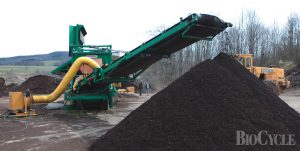
A vacuum separator positioned over the output conveyor of the trommel removes remaining contaminants from the screened compost.
Currently the only glitch in the office composting program is the size of the bamboo kitchen collection containers. “They are too small,” Durst says. “Someone has to empty and wash them out frequently because they are tiny. The bins need to be sized more appropriately.”
Durst plans to start talking to commercial tenants in the Bank of America Tower to see if they are interested in an office composting program. There will be an additional cost, due to the extra labor involved with collecting the food waste in the offices. “It is going to be a luxury product and not for all,” Durst says. “We are still trying to figure it out.”
Diane Greer is a Contributing Editor to BioCycle.


